
fabrice-ai
A lightweight, functional, and composable framework for building AI agents. No PhD required.
Stars: 223
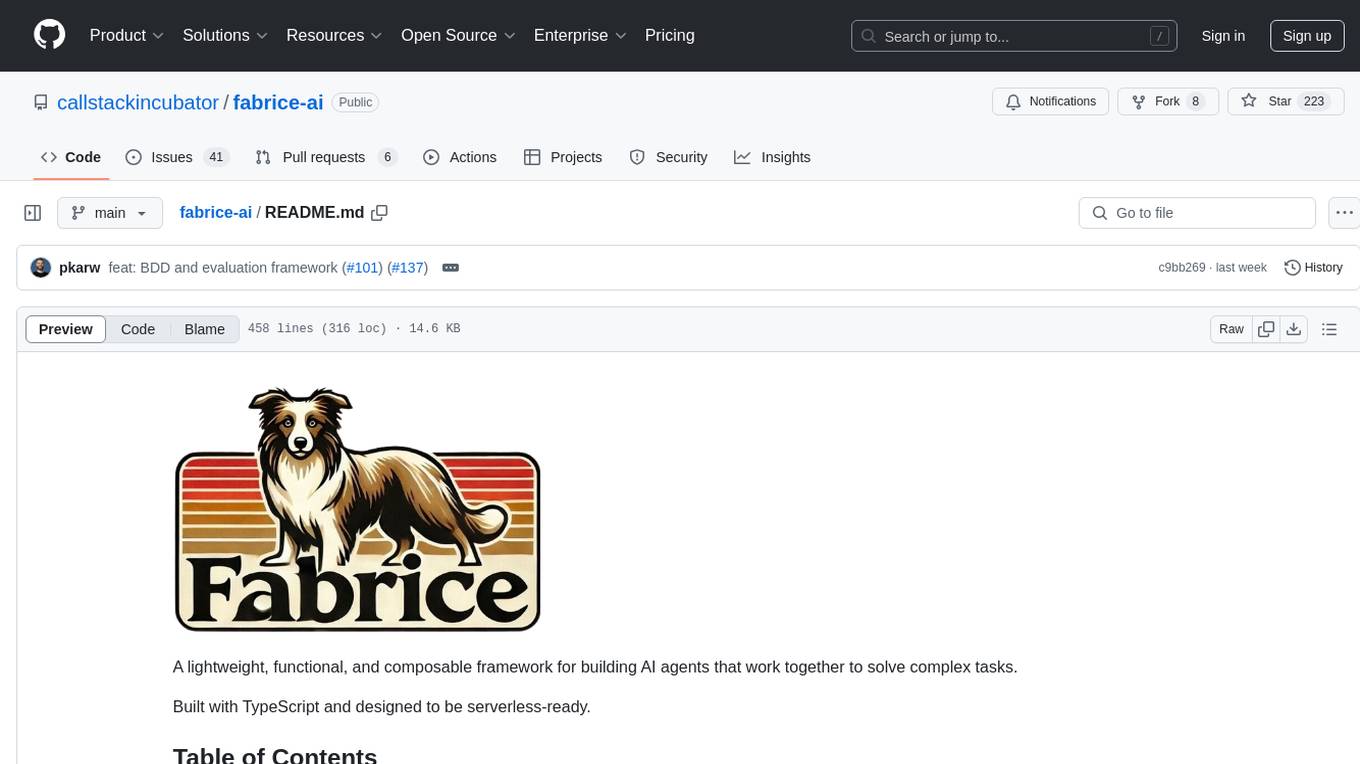
A lightweight, functional, and composable framework for building AI agents that work together to solve complex tasks. Built with TypeScript and designed to be serverless-ready. Fabrice embraces functional programming principles, remains stateless, and stays focused on composability. It provides core concepts like easy teamwork creation, infrastructure-agnosticism, statelessness, and includes all tools and features needed to build AI teams. Agents are specialized workers with specific roles and capabilities, able to call tools and complete tasks. Workflows define how agents collaborate to achieve a goal, with workflow states representing the current state of the workflow. Providers handle requests to the LLM and responses. Tools extend agent capabilities by providing concrete actions they can perform. Execution involves running the workflow to completion, with options for custom execution and BDD testing.
README:
A lightweight, functional, and composable framework for building AI agents that work together to solve complex tasks.
Built with TypeScript and designed to be serverless-ready.
- Getting Started
- Why Another AI Agent Framework?
- Core Concepts
- Agents
- Workflows
- Workflow States
- Providers
- Tools
- Execution
- Test framework
- Contributors
- Made with ❤️ at Callstack
It is very easy to get started. All you have to do is to create a file with your agents and workflow, then run it.
Use our creator tool to quickly create a new AI agent project.
npx create-fabrice-aiYou can choose from a few templates. You can see a full list of them here.
npm install fabrice-aiHere is a simple example of a workflow that researches and plans a trip to Wrocław, Poland:
import { agent } from 'fabrice-ai/agent'
import { teamwork } from 'fabrice-ai/teamwork'
import { solution, workflow } from 'fabrice-ai/workflow'
import { lookupWikipedia } from './tools/wikipedia.js'
const activityPlanner = agent({
description: `You are skilled at creating personalized itineraries...`,
})
const landmarkScout = agent({
description: `You research interesting landmarks...`,
tools: { lookupWikipedia },
})
const workflow = workflow({
team: { activityPlanner, landmarkScout },
description: `Plan a trip to Wrocław, Poland...`,
})
const result = await teamwork(workflow)
console.log(solution(result))Finally, you can run the example by simply executing the file.
Using bun
bun your_file.tsUsing node
node --import=tsx your_file.tsMost existing AI agent frameworks are either too complex, heavily object-oriented, or tightly coupled to specific infrastructure.
We wanted something different - a framework that embraces functional programming principles, remains stateless, and stays laser-focused on composability.
Now, English + Typescript is your tech stack.
Here are the core concepts of Fabrice:
Teamwork should be easy and fun, just like in real life. It should not require you to learn a new framework and mental model to put your AI team together.
There should be no assumptions about the infrastructure you're using. You should be able to use any provider and any tools, in any environment.
No classes, no side effects. Every operation should be a function that returns a new state.
We should provide you with all tools and features needed to build your AI team, locally and in the cloud.
Agents are specialized workers with specific roles and capabilities. Agents can call available tools and complete assigned tasks. Depending on the task complexity, it can be done in a single step, or multiple steps.
To create a custom agent, you can use our agent helper function or implement the Agent interface manually.
import { agent } from 'fabrice-ai/agent'
const myAgent = agent({
role: '<< your role >>',
description: '<< your description >>',
})Additionally, you can give it access to tools by passing a tools property to the agent. You can learn more about tools here. You can also set custom provider for each agent. You can learn more about providers here.
Fabrice comes with a few built-in agents that help it run your workflows out of the box.
Supervisor, supervisor, is responsible for coordinating the workflow.
It splits your workflow into smaller, more manageable parts, and coordinates the execution.
Resource Planner, resourcePlanner, is responsible for assigning tasks to available agents, based on their capabilities.
Final Boss, finalBoss, is responsible for wrapping up the workflow and providing a final output,
in case total number of iterations exeeceds available threshold.
You can overwrite built-in agents by setting it in the workflow.
For example, to replace built-in supervisor agent, you can do it like this:
import { supervisor } from './my-supervisor.js'
workflow({
team: { supervisor },
})Workflows define how agents collaborate to achieve a goal. They specify:
- Team members
- Task description
- Expected output
- Optional configuration
Workflow state is a representation of the current state of the workflow. It is a tree of states, where each state represents a single agent's work.
At each level, we have the following properties:
-
agent: name of the agent that is working on the task -
status: status of the agent -
messages: message history -
children: child states
First element of the messages array is always a request to the agent, typically a user message. Everything that follows is a message history, including all the messages exchanged with the provider.
Workflow can have multiple states:
-
idle: no work has been started yet -
running: work is in progress -
paused: work is paused and there are tools that must be called to resume -
finished: work is complete -
failed: work has failed due to an error
When you run teamwork(workflow), initial state is automatically created for you by calling rootState(workflow) behind the scenes.
[!NOTE] You can also provide your own initial state (for example, to resume a workflow from a previous state). You can learn more about it in the server-side usage section.
Root state is a special state that contains an initial request based on the workflow and points to the supervisor agent, which is responsible for splitting the work into smaller, more manageable parts.
You can learn more about the supervisor agent here.
Child state is like root state, but it points to any agent, such as one from your team.
You can create it manually, or use childState function.
const child = childState({
agent: '<< agent name >>',
messages: user('<< task description >>'),
})[!TIP] Fabrice exposes a few helpers to facilitate creating messages, such as
userandassistant. You can use them to create messages in a more readable way, although it is not required.
To delegate the task, just add a new child state to your agent's state.
const state = {
...state,
children: [
...state.children,
childState({
/** agent to work on the task */
agent: '<< agent name >>',
/** task description */
messages: [
{
role: 'user',
content: '<< task description >>',
}
],
})
]
}To make it easier, you can use delegate function to delegate the task.
const state = delegate(state, [agent, '<< task description >>'])To hand off the task, you can replace your agent's state with a new state, that points to a different agent.
const state = childState({
agent: '<< new agent name >>',
messages: state.messages,
})In the example above, we're passing the entire message history to the new agent, including the original request and all the work done by any previous agent. It is up to you to decide how much of the history to pass to the new agent.
Providers are responsible for sending requests to the LLM and handling the responses.
Fabrice comes with a few built-in providers:
- OpenAI (structured output)
- OpenAI (using tools as response format)
- Groq
You can learn more about them here.
If you're working with an OpenAI compatible provider, you can use the openai provider with a different base URL and API key, such as:
openai({
model: '<< your model >>',
options: {
apiKey: '<< your_api_key >>',
baseURL: '<< your_base_url >>',
},
})By default, Fabrice uses OpenAI gpt-4o model. You can change the default model or provider either for the entire system, or for specific agent.
To do it for the entire workflow:
import { grok } from 'fabrice-ai/providers/grok'
workflow({
/** other options go here */
provider: grok()
})To change it for specific agent:
import { grok } from 'fabrice-ai/providers/grok'
agent({
/** other options go here */
provider: grok()
})Note that an agent's provider always takes precedence over a workflow's provider. Tools always receive the provider from the agent that triggered their execution.
To create a custom provider, you need to implement the Provider interface.
const myProvider = (options: ProviderOptions): Provider => {
return {
chat: async () => {
/** your implementation goes here */
},
}
}You can learn more about the Provider interface here.
Tools extend agent capabilities by providing concrete actions they can perform.
Fabrice comes with a few built-in tools via @fabrice-ai/tools package. For most up-to-date list, please refer to the README.
To create a custom tool, you can use our tool helper function or implement the Tool interface manually.
import { tool } from 'fabrice-ai/tools'
const myTool = tool({
description: 'My tool description',
parameters: z.object({
/** your Zod schema goes here */
}),
execute: async (parameters, context) => {
/** your implementation goes here */
},
})Tools will use the same provider as the agent that triggered them. Additionally, you can access the context object, which gives you access to the provider, as well as current message history.
To give an agent access to a tool, you need to add it to the agent's tools property.
agent({
role: '<< your role >>',
tools: { searchWikipedia },
})Since tools are passed to an LLM and referred by their key, you should use meaningful names for them, for increased effectiveness.
Execution is the process of running the workflow to completion. A completed workflow is a workflow with state "finished" at its root.
The easiest way to complete the workflow is to call teamwork(workflow) function. It will run the workflow to completion and return the final state.
const state = await teamwork(workflow)
console.log(solution(state))Calling solution(state) will return the final output of the workflow, which is its last message.
If you are running workflows in the cloud, or any other environment where you want to handle tool execution manually, you can call teamwork the following way:
/** read state from the cache */
/** run the workflow */
const state = await teamwork(workflow, prevState, false)
/** save state to the cache */Passing second argument to teamwork is optional. If you don't provide it, root state will be created automatically. Otherwise, it will be used as a starting point for the next iteration.
Last argument is a boolean flag that determines if tools should be executed. If you set it to false, you are responsible for calling tools manually. Teamwork will stop iterating over the workflow and return the current state with paused status.
If you want to handle tool execution manually, you can use iterate function to build up your own recursive iteration logic over the workflow state.
Have a look at how teamwork is implemented here to understand how it works.
There's a packaged called fabrice-ai/bdd dedicated to unit testing - actually to Behavioral Driven Development. Check the docs.
|
Mike 💻 |
Piotr Karwatka 💻 |
Fabrice is an open source project and will always remain free to use. If you think it's cool, please star it 🌟. Callstack is a group of React and React Native geeks, contact us at [email protected] if you need any help with these or just want to say hi!
Like the project? ⚛️ Join the team who does amazing stuff for clients and drives React Native Open Source! 🔥
For Tasks:
Click tags to check more tools for each tasksFor Jobs:
Alternative AI tools for fabrice-ai
Similar Open Source Tools

fabrice-ai
A lightweight, functional, and composable framework for building AI agents that work together to solve complex tasks. Built with TypeScript and designed to be serverless-ready. Fabrice embraces functional programming principles, remains stateless, and stays focused on composability. It provides core concepts like easy teamwork creation, infrastructure-agnosticism, statelessness, and includes all tools and features needed to build AI teams. Agents are specialized workers with specific roles and capabilities, able to call tools and complete tasks. Workflows define how agents collaborate to achieve a goal, with workflow states representing the current state of the workflow. Providers handle requests to the LLM and responses. Tools extend agent capabilities by providing concrete actions they can perform. Execution involves running the workflow to completion, with options for custom execution and BDD testing.
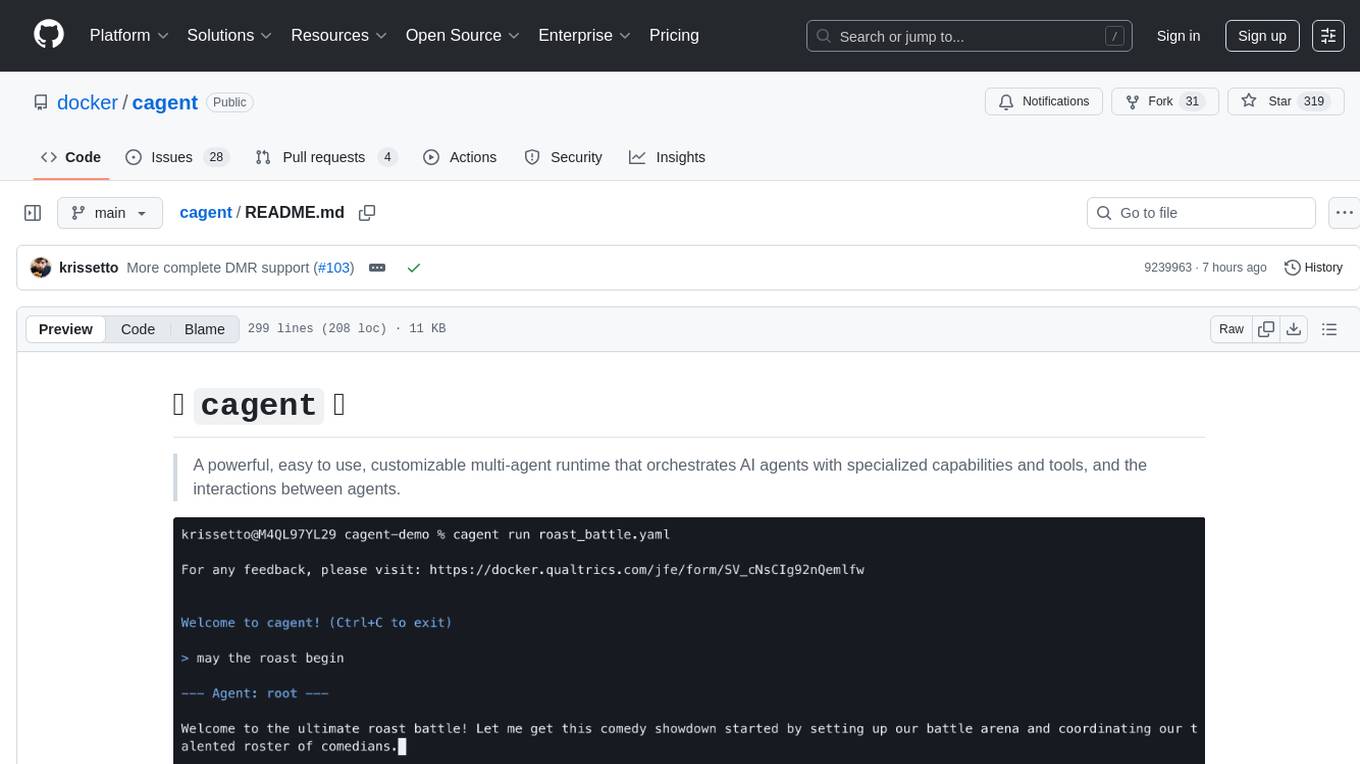
cagent
cagent is a powerful and easy-to-use multi-agent runtime that orchestrates AI agents with specialized capabilities and tools, allowing users to quickly build, share, and run a team of virtual experts to solve complex problems. It supports creating agents with YAML configuration, improving agents with MCP servers, and delegating tasks to specialists. Key features include multi-agent architecture, rich tool ecosystem, smart delegation, YAML configuration, advanced reasoning tools, and support for multiple AI providers like OpenAI, Anthropic, Gemini, and Docker Model Runner.
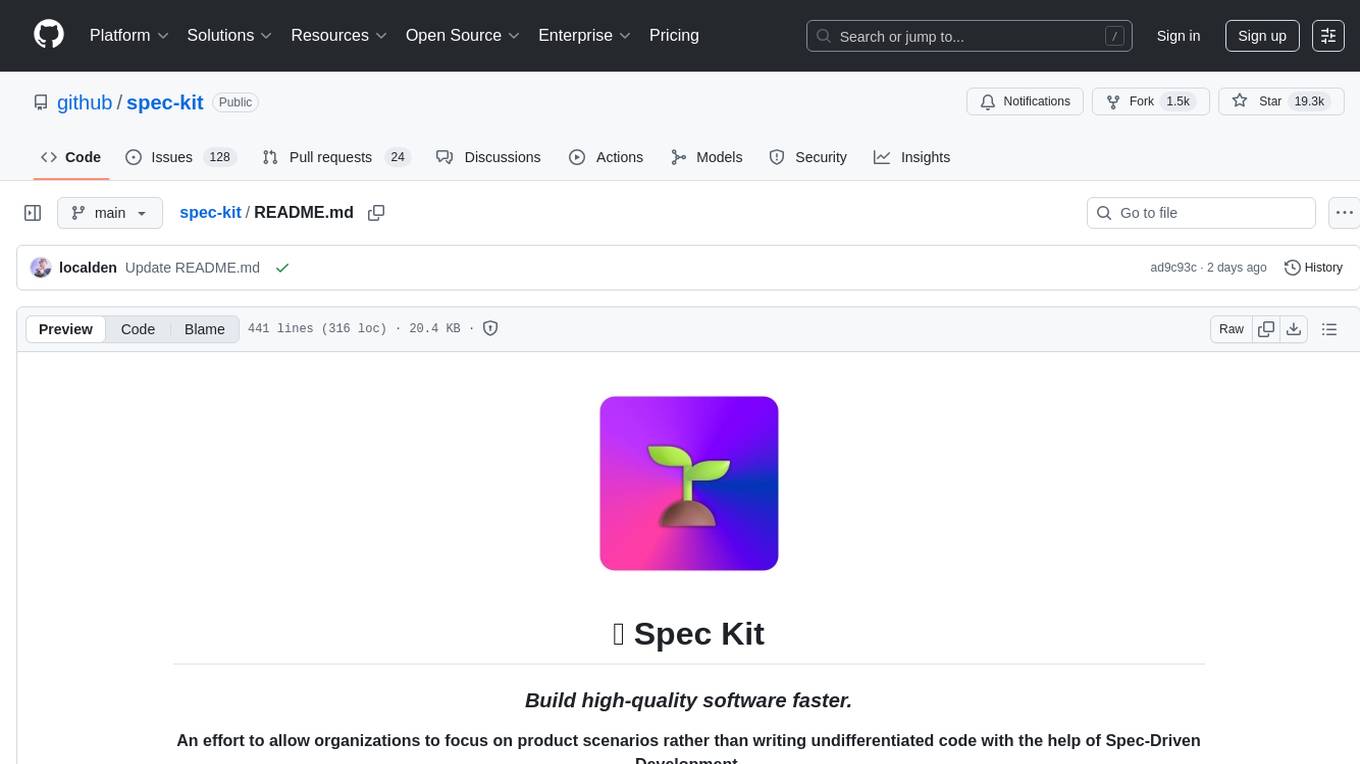
spec-kit
Spec Kit is a tool designed to enable organizations to focus on product scenarios rather than writing undifferentiated code through Spec-Driven Development. It flips the script on traditional software development by making specifications executable, directly generating working implementations. The tool provides a structured process emphasizing intent-driven development, rich specification creation, multi-step refinement, and heavy reliance on advanced AI model capabilities for specification interpretation. Spec Kit supports various development phases, including 0-to-1 Development, Creative Exploration, and Iterative Enhancement, and aims to achieve experimental goals related to technology independence, enterprise constraints, user-centric development, and creative & iterative processes. The tool requires Linux/macOS (or WSL2 on Windows), an AI coding agent (Claude Code, GitHub Copilot, Gemini CLI, or Cursor), uv for package management, Python 3.11+, and Git.
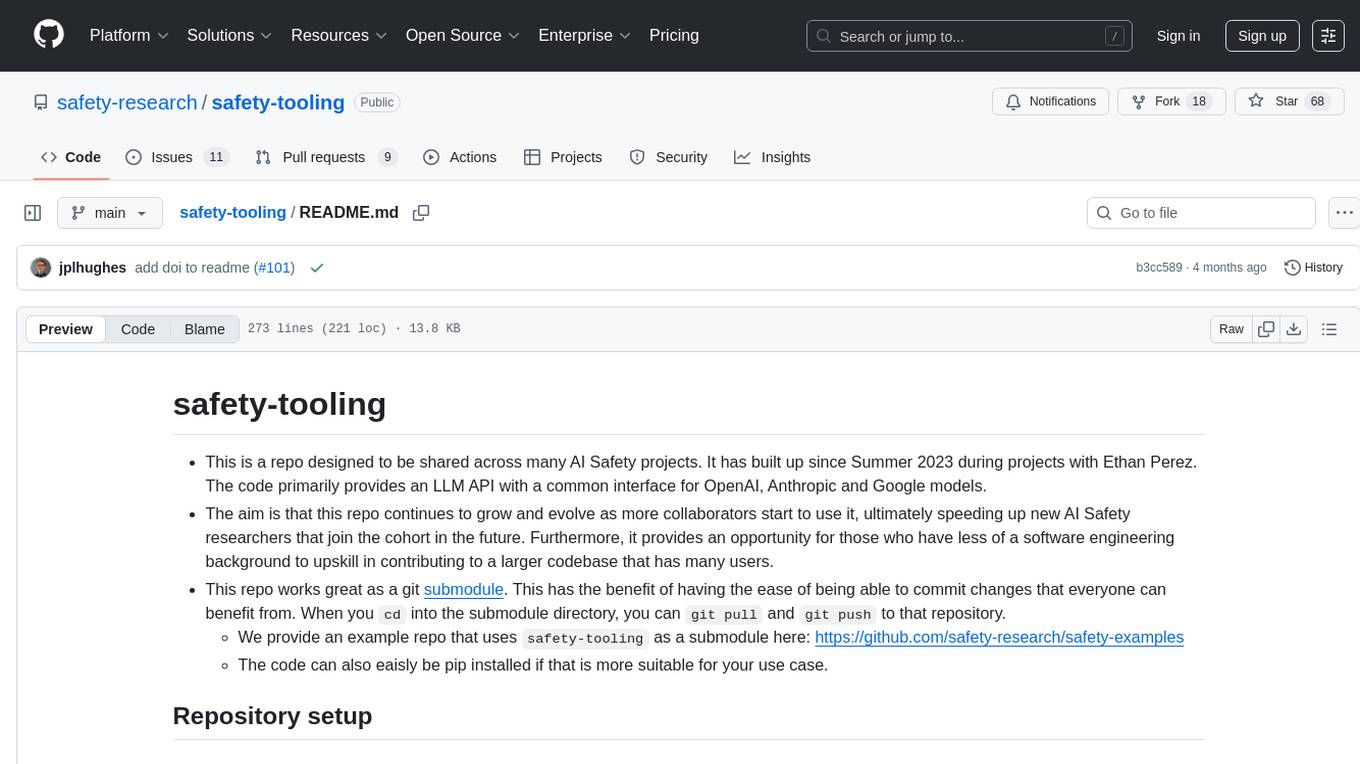
safety-tooling
This repository, safety-tooling, is designed to be shared across various AI Safety projects. It provides an LLM API with a common interface for OpenAI, Anthropic, and Google models. The aim is to facilitate collaboration among AI Safety researchers, especially those with limited software engineering backgrounds, by offering a platform for contributing to a larger codebase. The repo can be used as a git submodule for easy collaboration and updates. It also supports pip installation for convenience. The repository includes features for installation, secrets management, linting, formatting, Redis configuration, testing, dependency management, inference, finetuning, API usage tracking, and various utilities for data processing and experimentation.
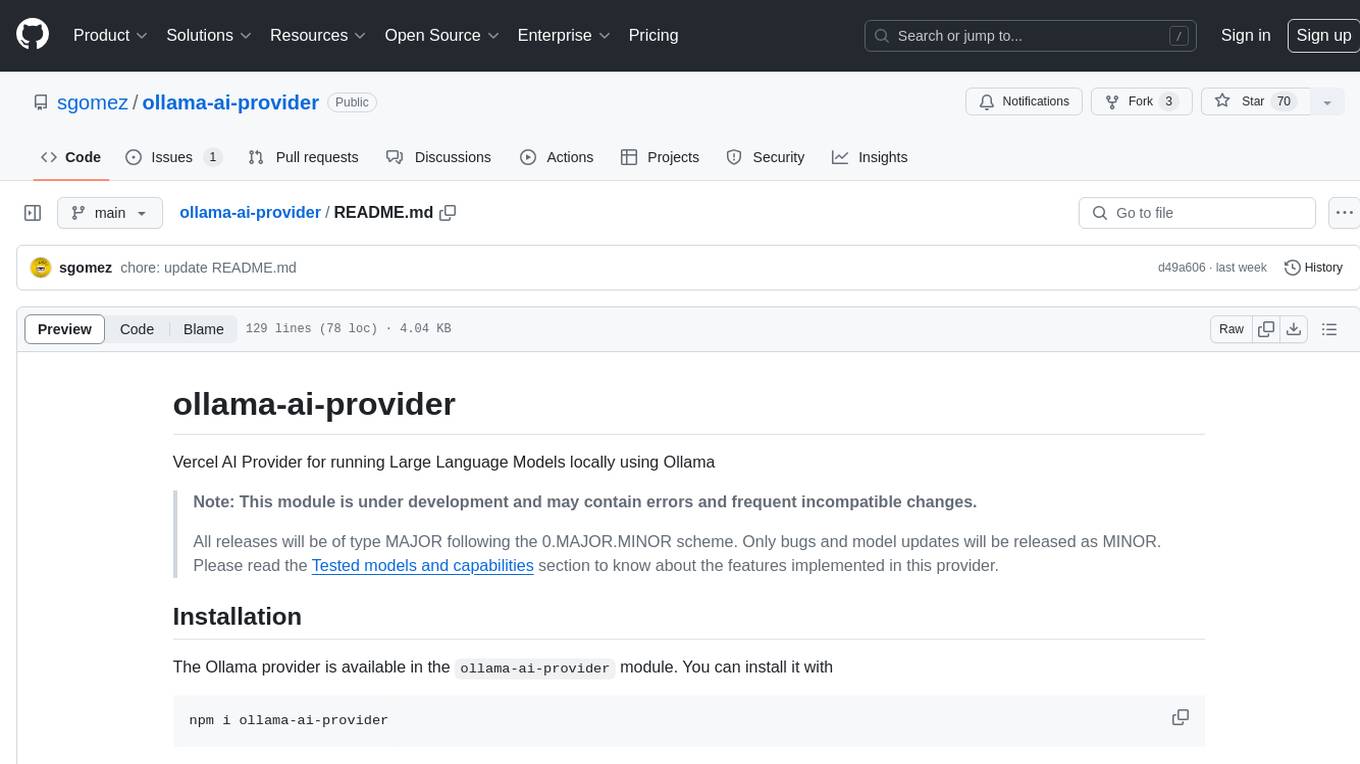
ollama-ai-provider
Vercel AI Provider for running Large Language Models locally using Ollama. This module is under development and may contain errors and frequent incompatible changes. It provides the capability of generating and streaming text and objects, with features like image input, object generation, tool usage simulation, tool streaming simulation, intercepting fetch requests, and provider management. The provider can be customized with optional settings like baseURL and headers.
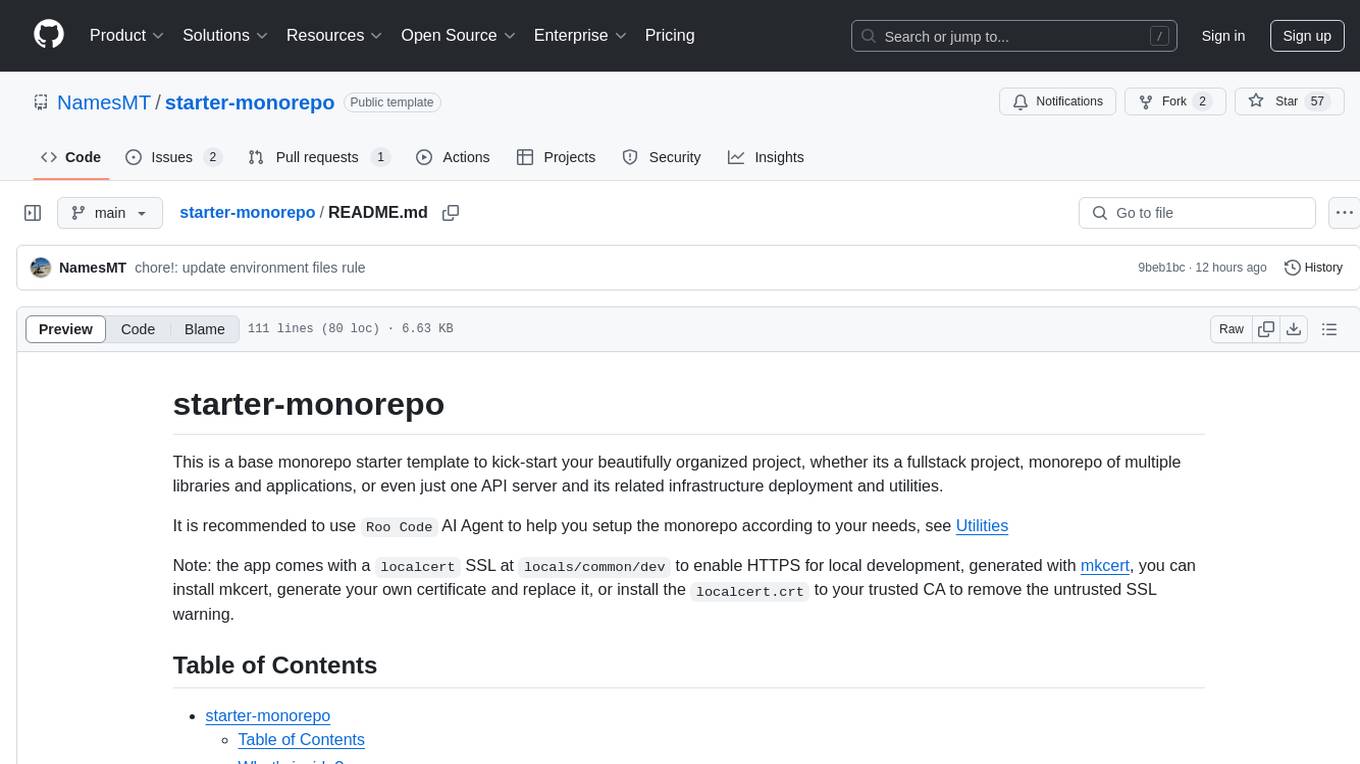
starter-monorepo
Starter Monorepo is a template repository for setting up a monorepo structure in your project. It provides a basic setup with configurations for managing multiple packages within a single repository. This template includes tools for package management, versioning, testing, and deployment. By using this template, you can streamline your development process, improve code sharing, and simplify dependency management across your project. Whether you are working on a small project or a large-scale application, Starter Monorepo can help you organize your codebase efficiently and enhance collaboration among team members.

telemetry-airflow
This repository codifies the Airflow cluster that is deployed at workflow.telemetry.mozilla.org (behind SSO) and commonly referred to as "WTMO" or simply "Airflow". Some links relevant to users and developers of WTMO: * The `dags` directory in this repository contains some custom DAG definitions * Many of the DAGs registered with WTMO don't live in this repository, but are instead generated from ETL task definitions in bigquery-etl * The Data SRE team maintains a WTMO Developer Guide (behind SSO)
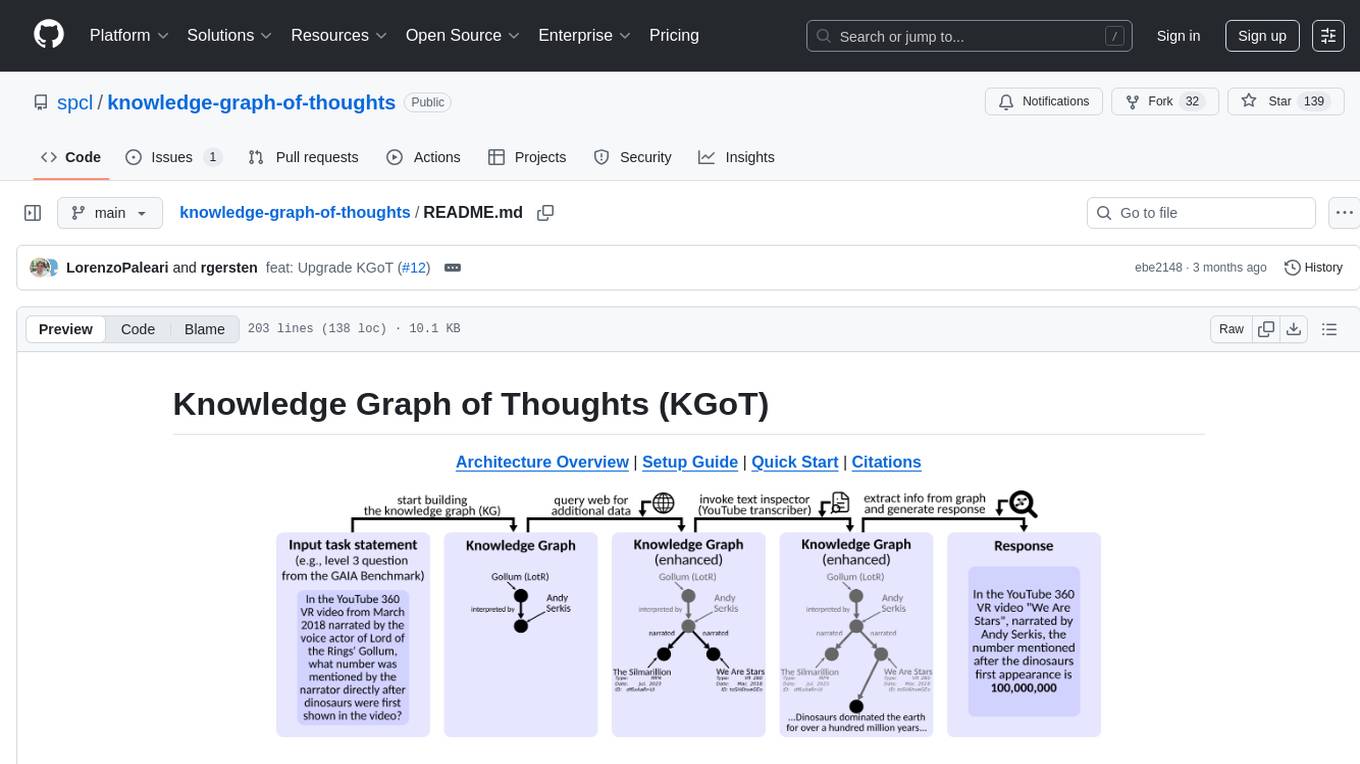
knowledge-graph-of-thoughts
Knowledge Graph of Thoughts (KGoT) is an innovative AI assistant architecture that integrates LLM reasoning with dynamically constructed knowledge graphs (KGs). KGoT extracts and structures task-relevant knowledge into a dynamic KG representation, iteratively enhanced through external tools such as math solvers, web crawlers, and Python scripts. Such structured representation of task-relevant knowledge enables low-cost models to solve complex tasks effectively. The KGoT system consists of three main components: the Controller, the Graph Store, and the Integrated Tools, each playing a critical role in the task-solving process.
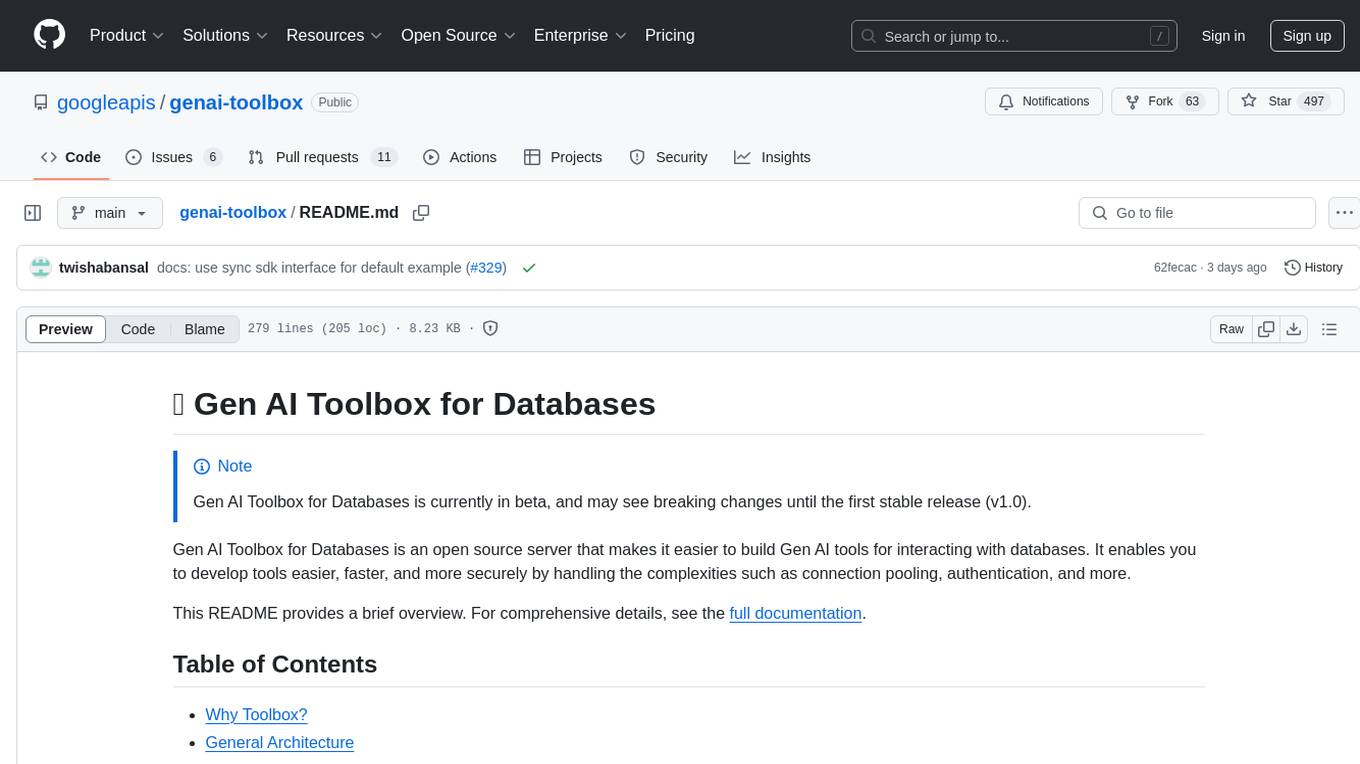
genai-toolbox
Gen AI Toolbox for Databases is an open source server that simplifies building Gen AI tools for interacting with databases. It handles complexities like connection pooling, authentication, and more, enabling easier, faster, and more secure tool development. The toolbox sits between the application's orchestration framework and the database, providing a control plane to modify, distribute, or invoke tools. It offers simplified development, better performance, enhanced security, and end-to-end observability. Users can install the toolbox as a binary, container image, or compile from source. Configuration is done through a 'tools.yaml' file, defining sources, tools, and toolsets. The project follows semantic versioning and welcomes contributions.
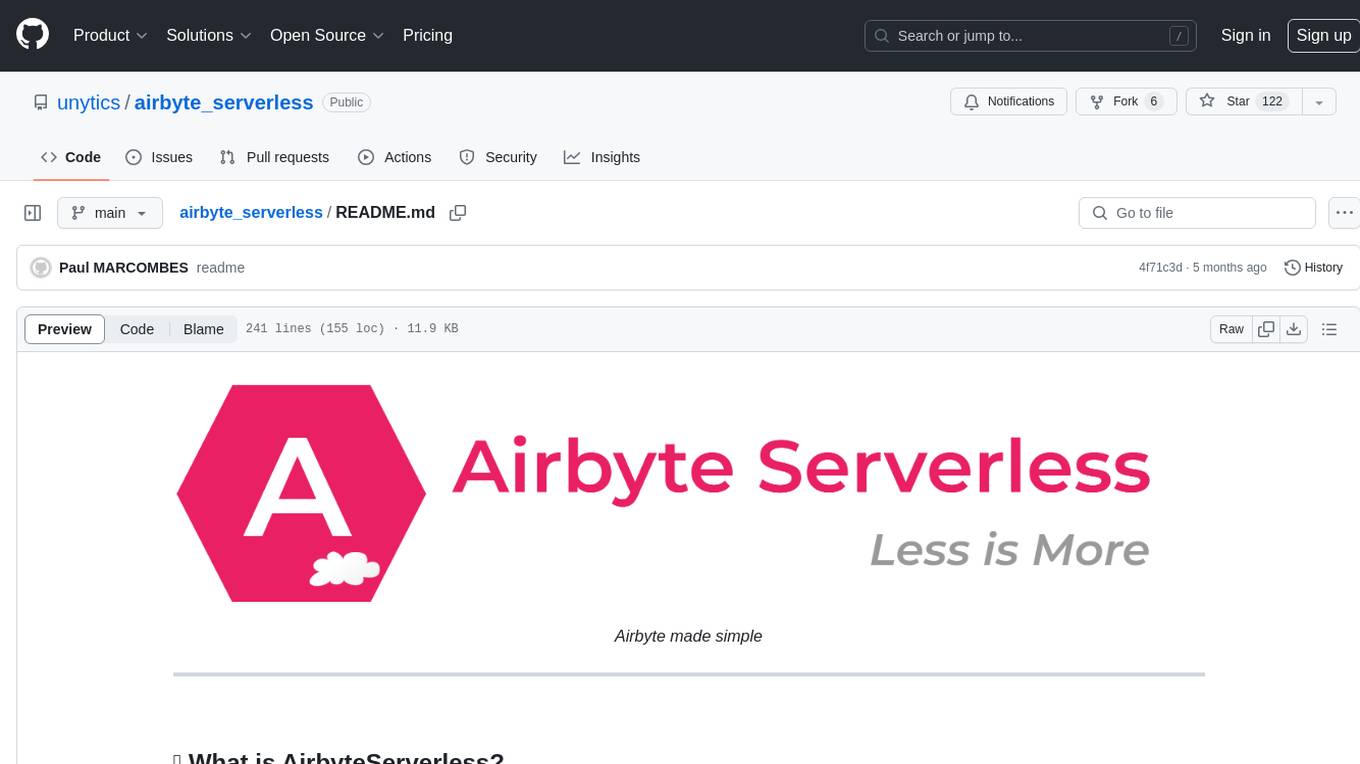
airbyte_serverless
AirbyteServerless is a lightweight tool designed to simplify the management of Airbyte connectors. It offers a serverless mode for running connectors, allowing users to easily move data from any source to their data warehouse. Unlike the full Airbyte-Open-Source-Platform, AirbyteServerless focuses solely on the Extract-Load process without a UI, database, or transform layer. It provides a CLI tool, 'abs', for managing connectors, creating connections, running jobs, selecting specific data streams, handling secrets securely, and scheduling remote runs. The tool is scalable, allowing independent deployment of multiple connectors. It aims to streamline the connector management process and provide a more agile alternative to the comprehensive Airbyte platform.
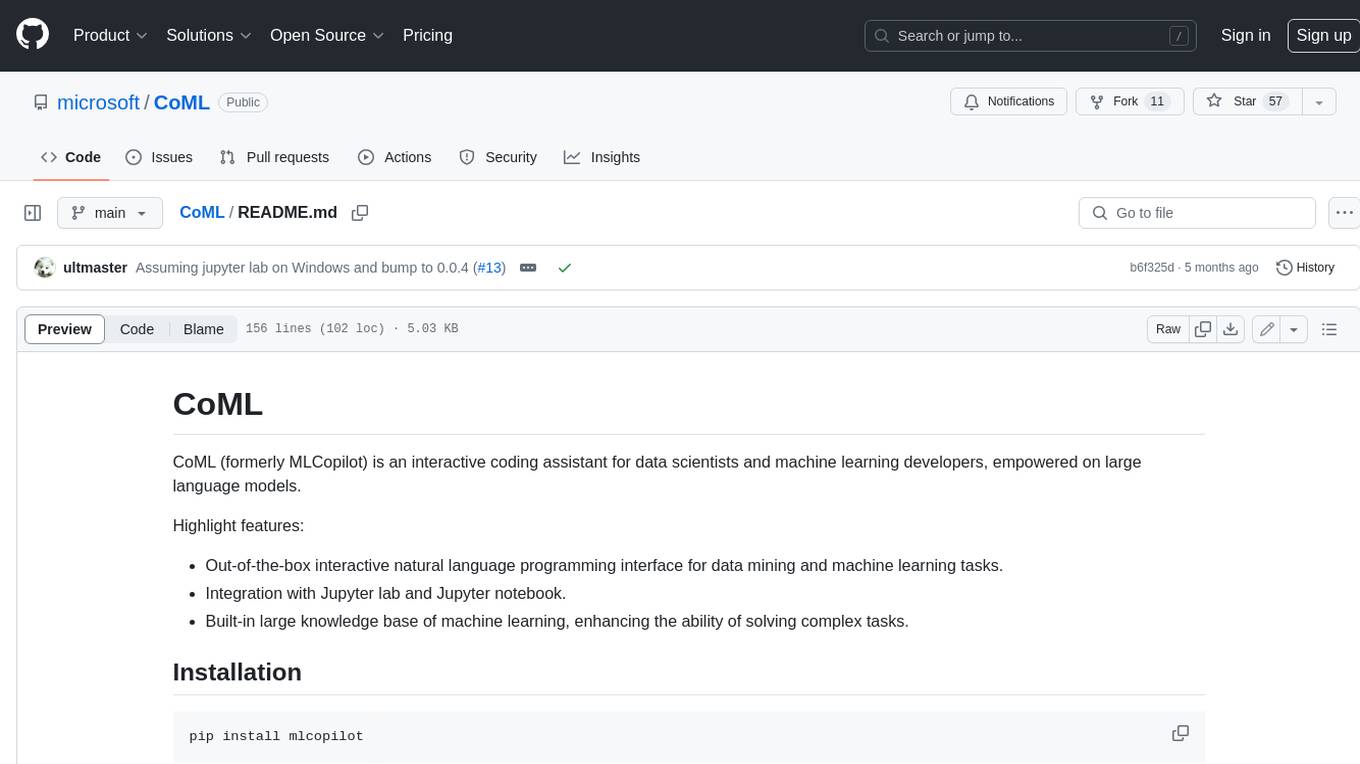
CoML
CoML (formerly MLCopilot) is an interactive coding assistant for data scientists and machine learning developers, empowered on large language models. It offers an out-of-the-box interactive natural language programming interface for data mining and machine learning tasks, integration with Jupyter lab and Jupyter notebook, and a built-in large knowledge base of machine learning to enhance the ability to solve complex tasks. The tool is designed to assist users in coding tasks related to data analysis and machine learning using natural language commands within Jupyter environments.
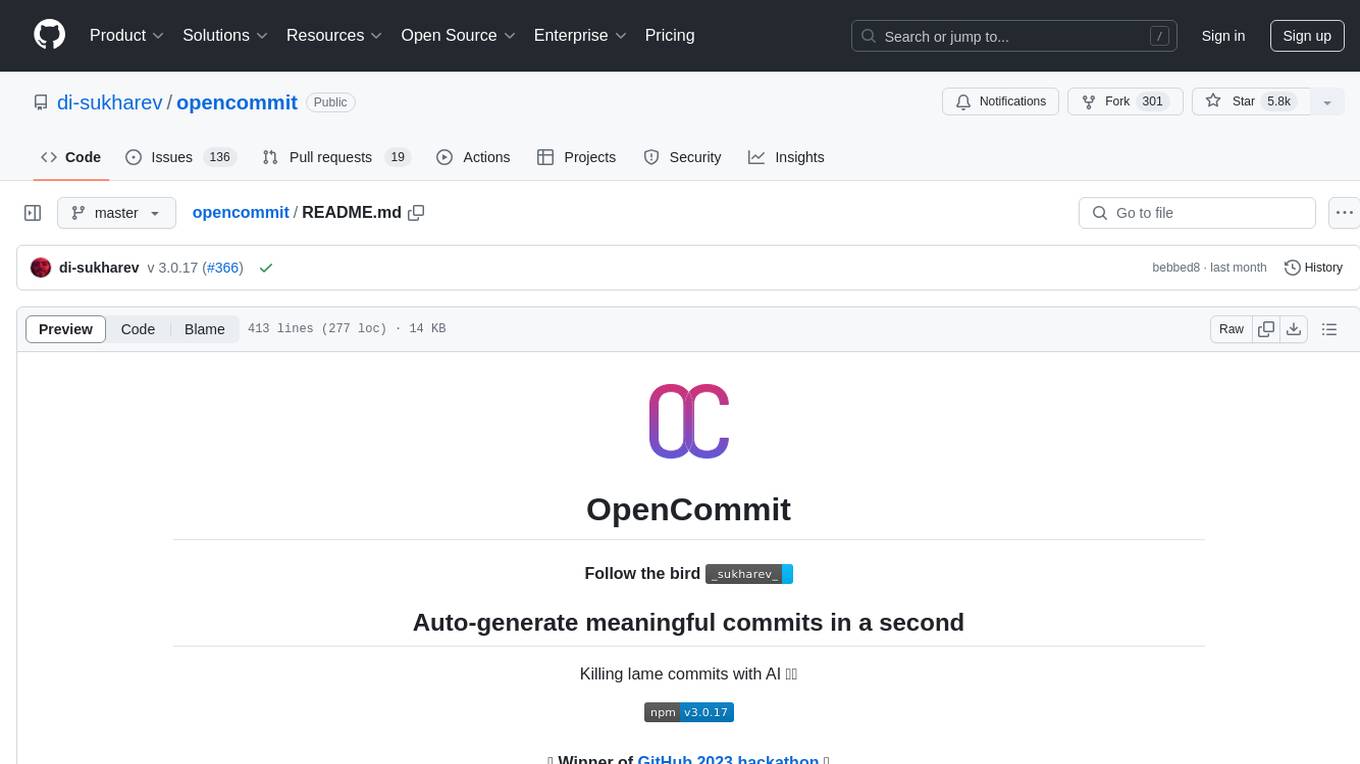
opencommit
OpenCommit is a tool that auto-generates meaningful commits using AI, allowing users to quickly create commit messages for their staged changes. It provides a CLI interface for easy usage and supports customization of commit descriptions, emojis, and AI models. Users can configure local and global settings, switch between different AI providers, and set up Git hooks for integration with IDE Source Control. Additionally, OpenCommit can be used as a GitHub Action to automatically improve commit messages on push events, ensuring all commits are meaningful and not generic. Payments for OpenAI API requests are handled by the user, with the tool storing API keys locally.
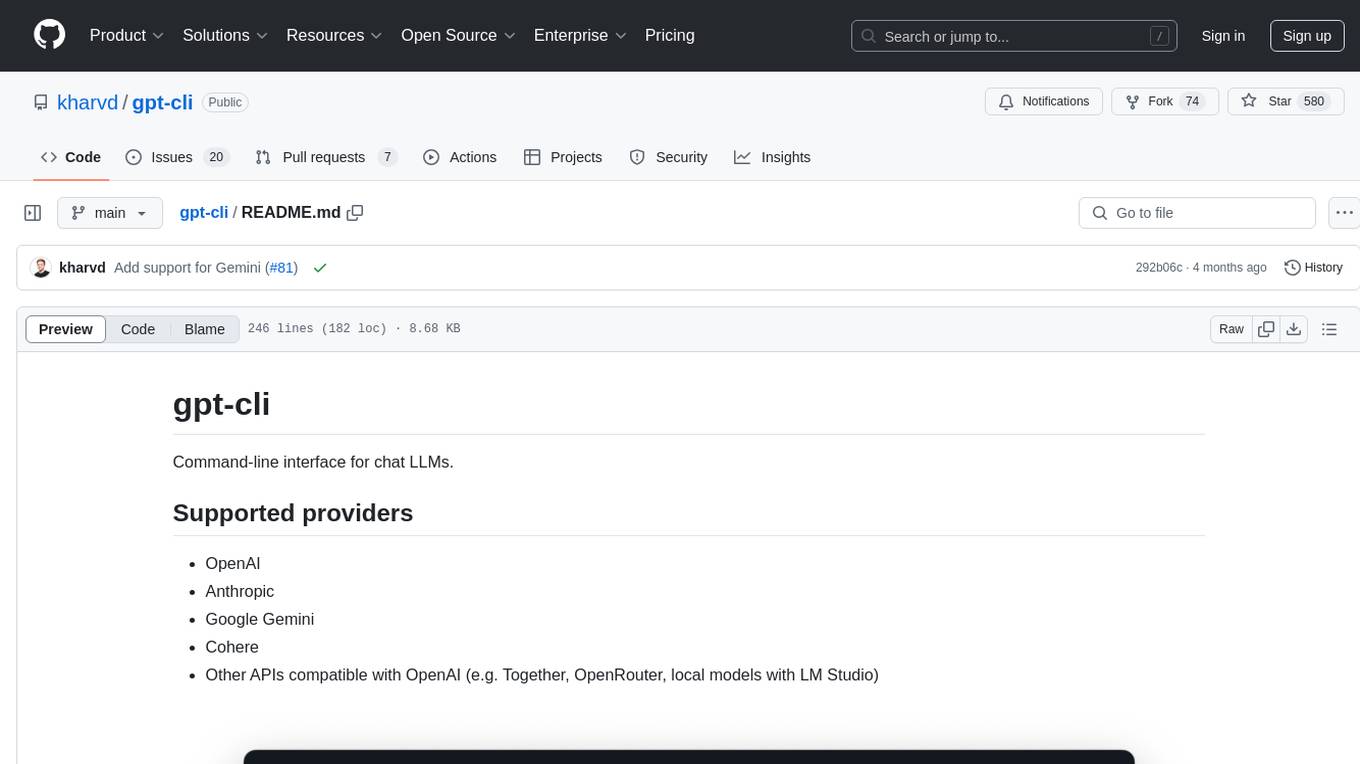
gpt-cli
gpt-cli is a command-line interface tool for interacting with various chat language models like ChatGPT, Claude, and others. It supports model customization, usage tracking, keyboard shortcuts, multi-line input, markdown support, predefined messages, and multiple assistants. Users can easily switch between different assistants, define custom assistants, and configure model parameters and API keys in a YAML file for easy customization and management.

reader
Reader is a tool that converts any URL to an LLM-friendly input with a simple prefix `https://r.jina.ai/`. It improves the output for your agent and RAG systems at no cost. Reader supports image reading, captioning all images at the specified URL and adding `Image [idx]: [caption]` as an alt tag. This enables downstream LLMs to interact with the images in reasoning, summarizing, etc. Reader offers a streaming mode, useful when the standard mode provides an incomplete result. In streaming mode, Reader waits a bit longer until the page is fully rendered, providing more complete information. Reader also supports a JSON mode, which contains three fields: `url`, `title`, and `content`. Reader is backed by Jina AI and licensed under Apache-2.0.
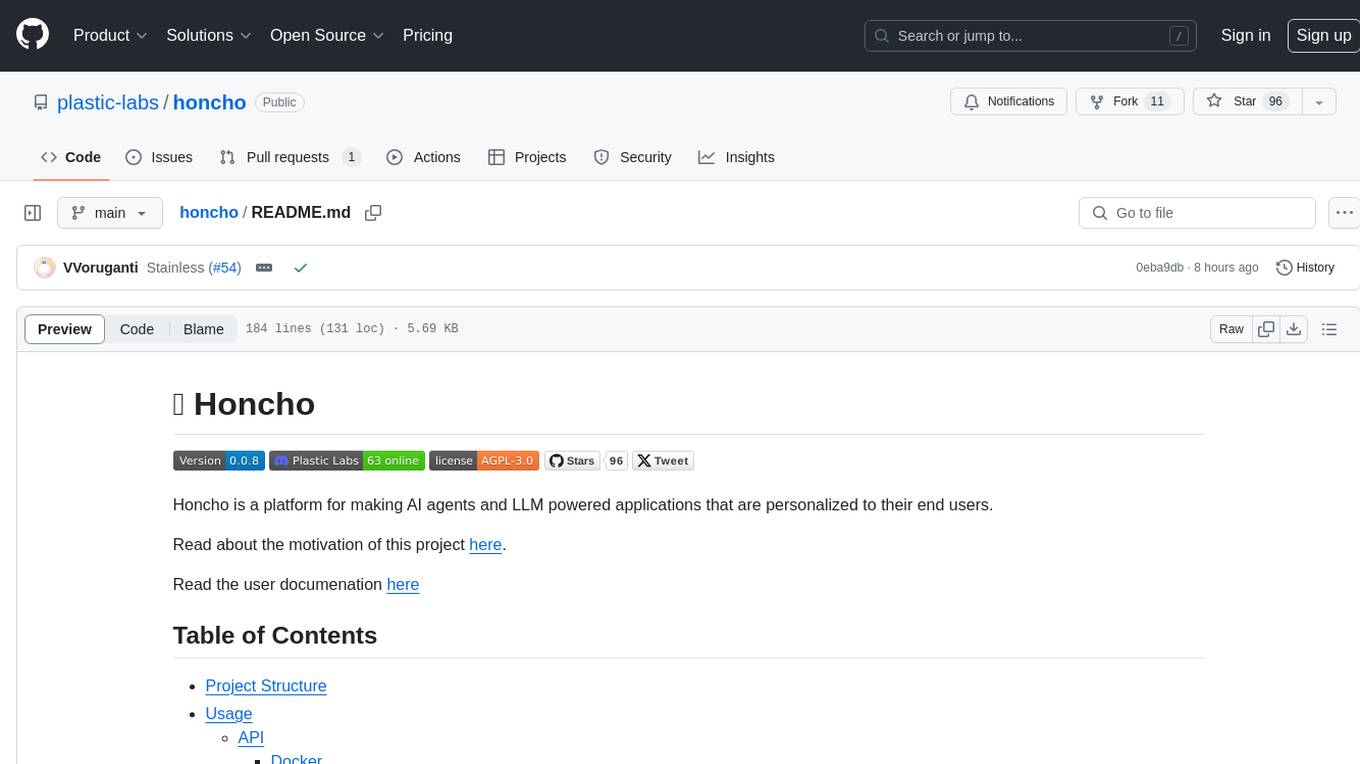
honcho
Honcho is a platform for creating personalized AI agents and LLM powered applications for end users. The repository is a monorepo containing the server/API for managing database interactions and storing application state, along with a Python SDK. It utilizes FastAPI for user context management and Poetry for dependency management. The API can be run using Docker or manually by setting environment variables. The client SDK can be installed using pip or Poetry. The project is open source and welcomes contributions, following a fork and PR workflow. Honcho is licensed under the AGPL-3.0 License.
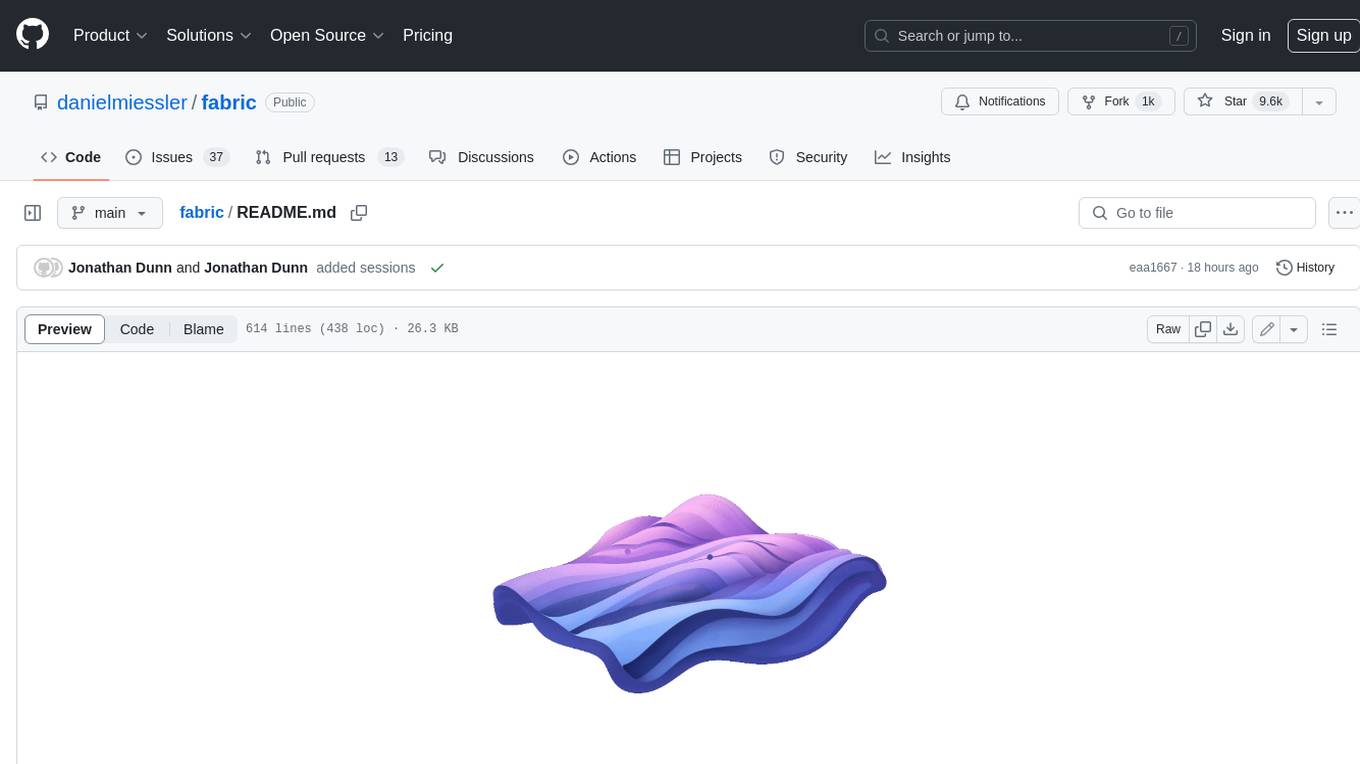
fabric
Fabric is an open-source framework for augmenting humans using AI. It provides a structured approach to breaking down problems into individual components and applying AI to them one at a time. Fabric includes a collection of pre-defined Patterns (prompts) that can be used for a variety of tasks, such as extracting the most interesting parts of YouTube videos and podcasts, writing essays, summarizing academic papers, creating AI art prompts, and more. Users can also create their own custom Patterns. Fabric is designed to be easy to use, with a command-line interface and a variety of helper apps. It is also extensible, allowing users to integrate it with their own AI applications and infrastructure.
For similar tasks
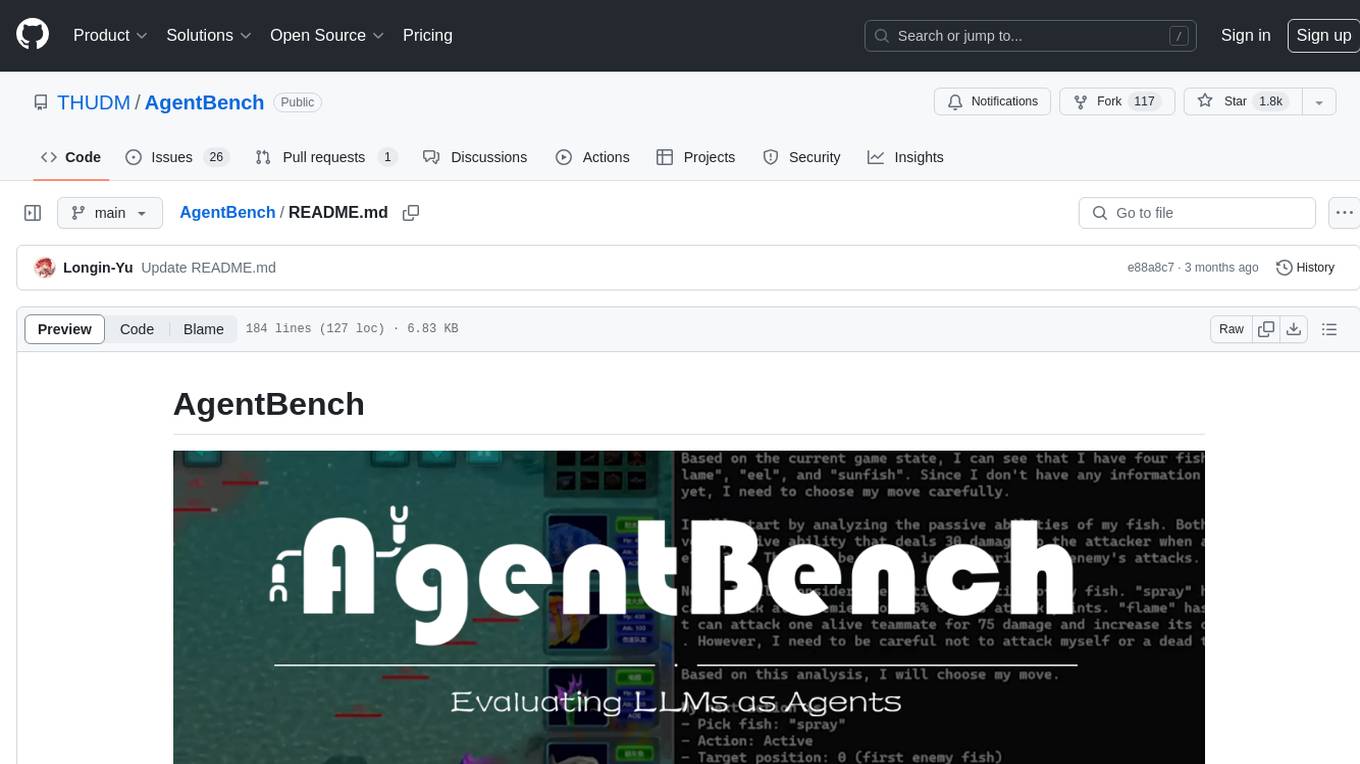
AgentBench
AgentBench is a benchmark designed to evaluate Large Language Models (LLMs) as autonomous agents in various environments. It includes 8 distinct environments such as Operating System, Database, Knowledge Graph, Digital Card Game, and Lateral Thinking Puzzles. The tool provides a comprehensive evaluation of LLMs' ability to operate as agents by offering Dev and Test sets for each environment. Users can quickly start using the tool by following the provided steps, configuring the agent, starting task servers, and assigning tasks. AgentBench aims to bridge the gap between LLMs' proficiency as agents and their practical usability.

fabrice-ai
A lightweight, functional, and composable framework for building AI agents that work together to solve complex tasks. Built with TypeScript and designed to be serverless-ready. Fabrice embraces functional programming principles, remains stateless, and stays focused on composability. It provides core concepts like easy teamwork creation, infrastructure-agnosticism, statelessness, and includes all tools and features needed to build AI teams. Agents are specialized workers with specific roles and capabilities, able to call tools and complete tasks. Workflows define how agents collaborate to achieve a goal, with workflow states representing the current state of the workflow. Providers handle requests to the LLM and responses. Tools extend agent capabilities by providing concrete actions they can perform. Execution involves running the workflow to completion, with options for custom execution and BDD testing.
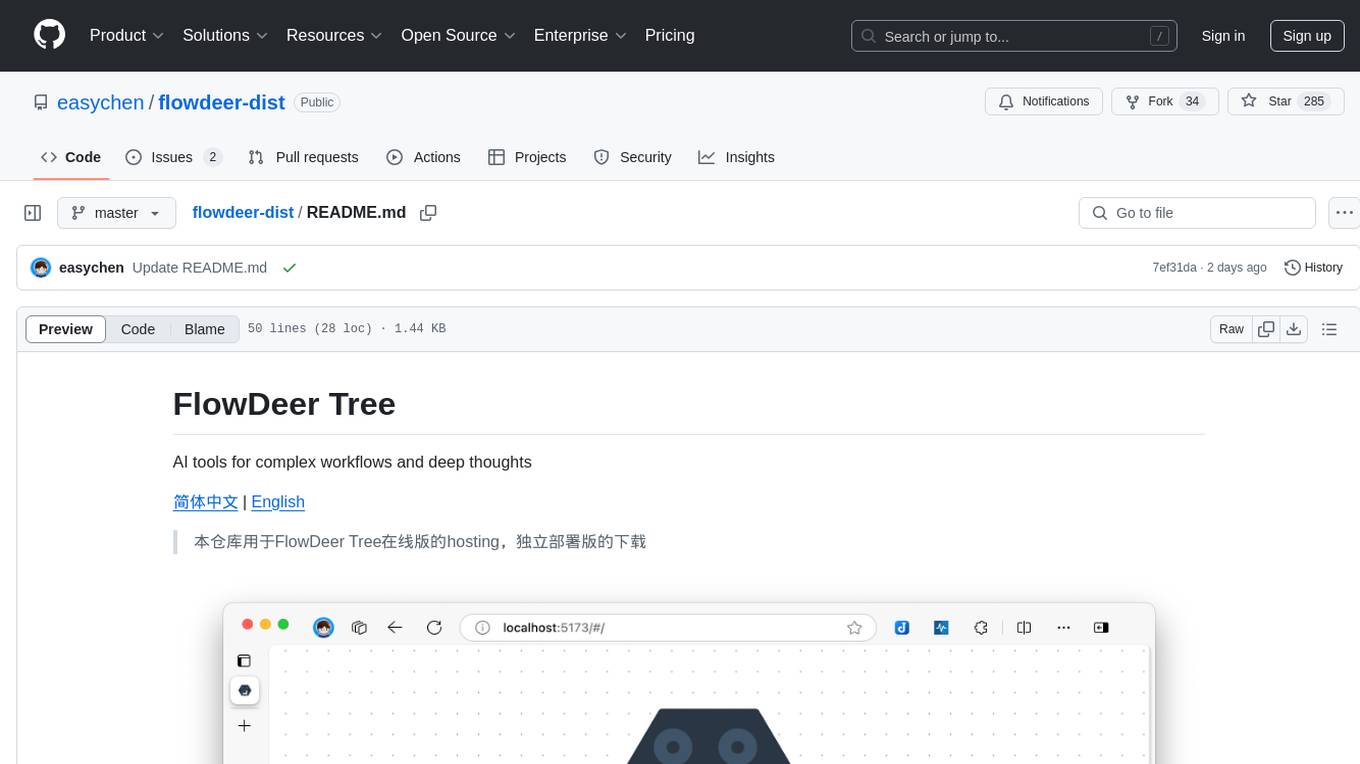
flowdeer-dist
FlowDeer Tree is an AI tool designed for managing complex workflows and facilitating deep thoughts. It provides features such as displaying thinking chains, assigning tasks to AI members, utilizing task conclusions as context, copying and importing AI members in JSON format, adjusting node sequences, calling external APIs as plugins, and customizing default task splitting, execution, summarization, and output rewriting prompts. The tool aims to streamline workflow processes and enhance productivity by leveraging artificial intelligence capabilities.

EpicStaff
EpicStaff is a powerful project management tool designed to streamline team collaboration and task management. It provides a user-friendly interface for creating and assigning tasks, tracking progress, and communicating with team members in real-time. With features such as task prioritization, deadline reminders, and file sharing capabilities, EpicStaff helps teams stay organized and productive. Whether you're working on a small project or managing a large team, EpicStaff is the perfect solution to keep everyone on the same page and ensure project success.
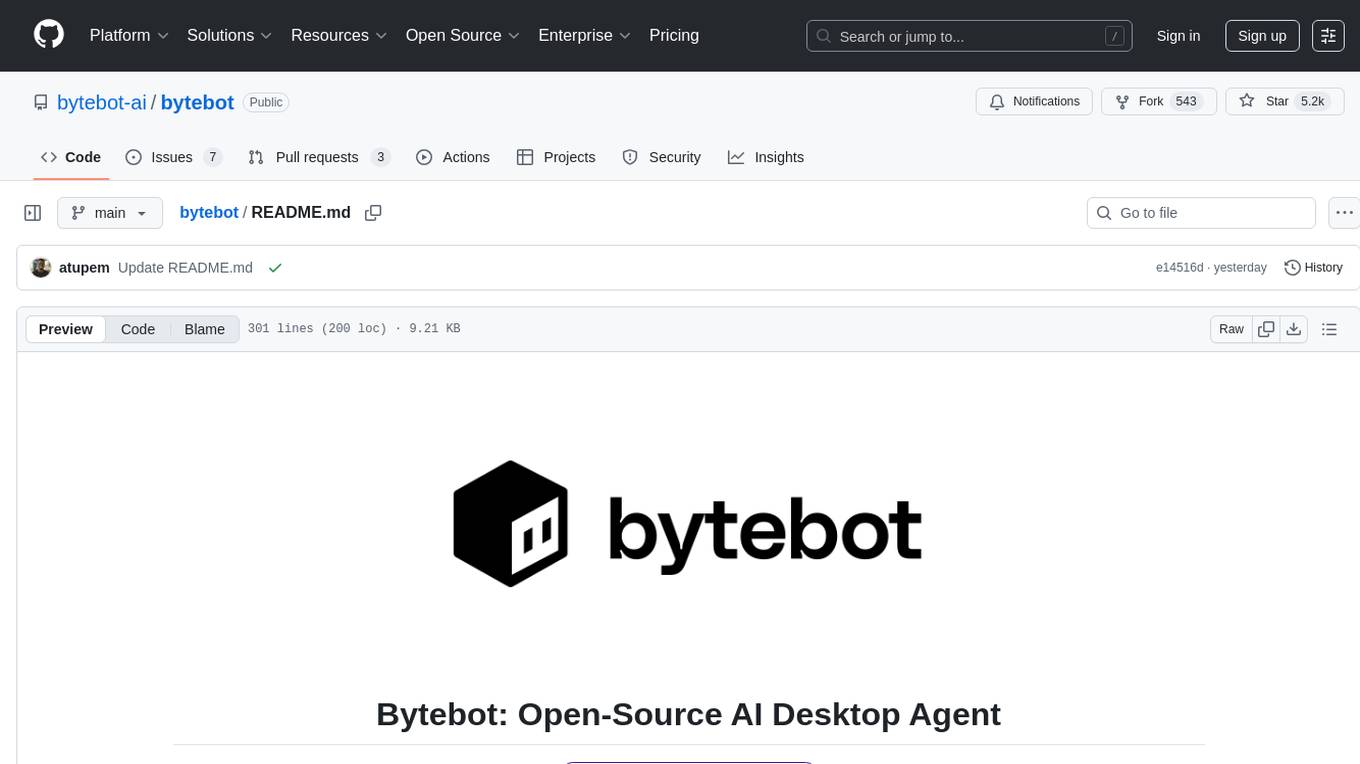
bytebot
Bytebot is an open-source AI desktop agent that provides a virtual employee with its own computer to complete tasks for users. It can use various applications, download and organize files, log into websites, process documents, and perform complex multi-step workflows. By giving AI access to a complete desktop environment, Bytebot unlocks capabilities not possible with browser-only agents or API integrations, enabling complete task autonomy, document processing, and usage of real applications.
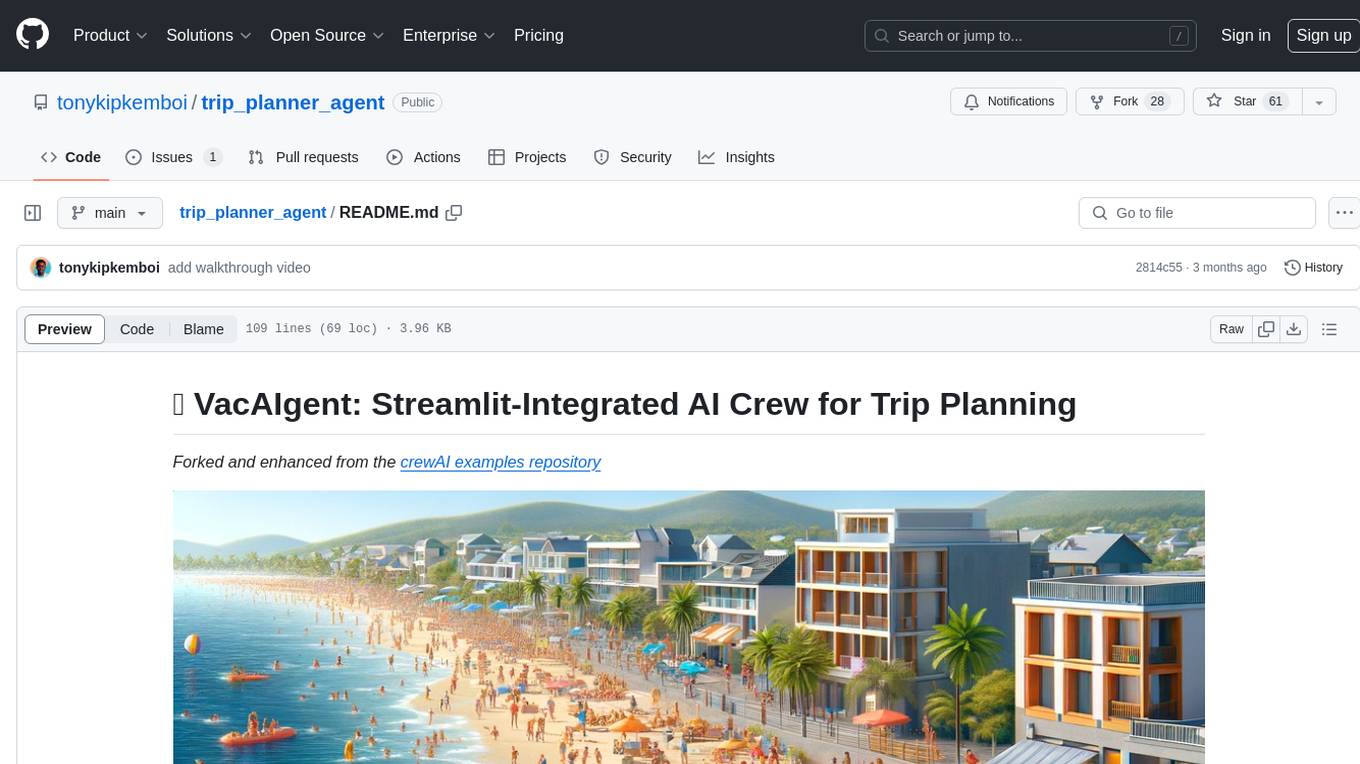
trip_planner_agent
VacAIgent is an AI tool that automates and enhances trip planning by leveraging the CrewAI framework. It integrates a user-friendly Streamlit interface for interactive travel planning. Users can input preferences and receive tailored travel plans with the help of autonomous AI agents. The tool allows for collaborative decision-making on cities and crafting complete itineraries based on specified preferences, all accessible via a streamlined Streamlit user interface. VacAIgent can be customized to use different AI models like GPT-3.5 or local models like Ollama for enhanced privacy and customization.
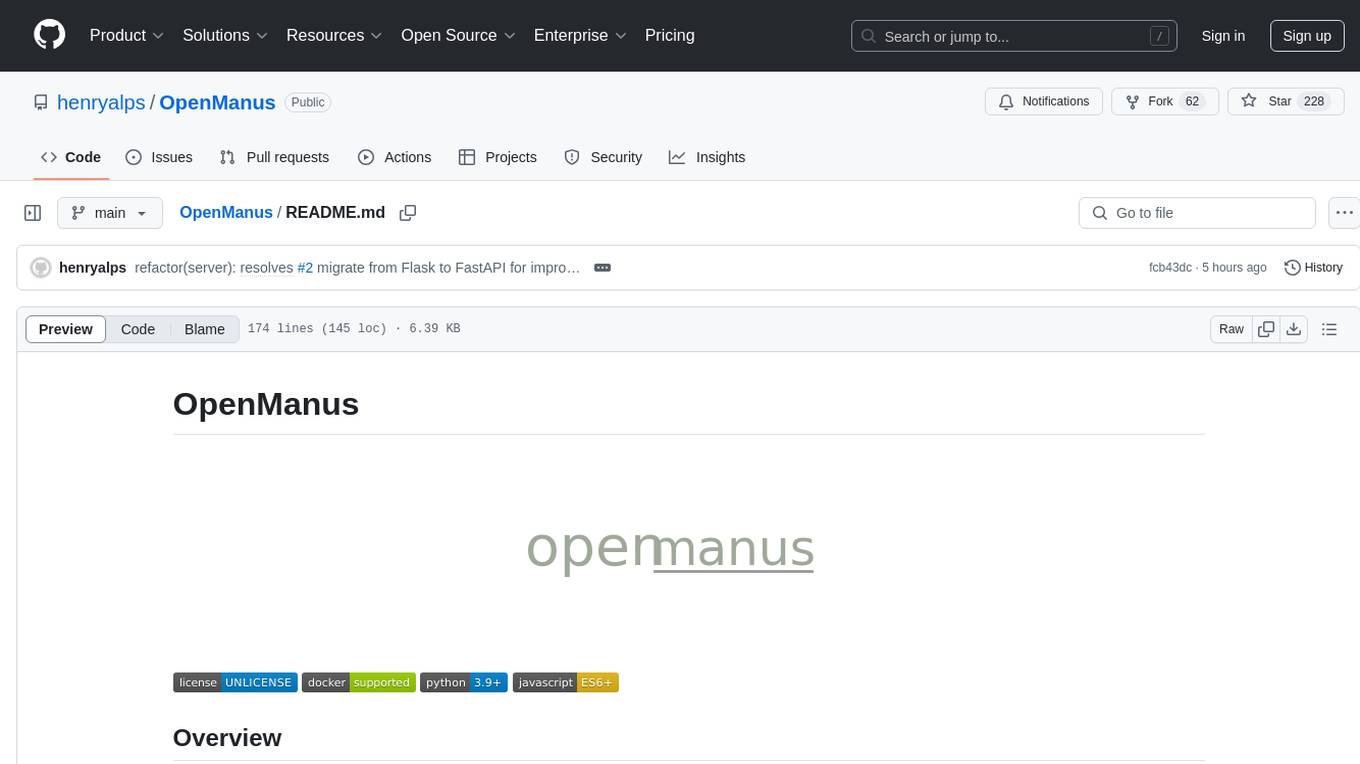
OpenManus
OpenManus is an open-source project aiming to replicate the capabilities of the Manus AI agent, known for autonomously executing complex tasks like travel planning and stock analysis. The project provides a modular, containerized framework using Docker, Python, and JavaScript, allowing developers to build, deploy, and experiment with a multi-agent AI system. Features include collaborative AI agents, Dockerized environment, task execution support, tool integration, modular design, and community-driven development. Users can interact with OpenManus via CLI, API, or web UI, and the project welcomes contributions to enhance its capabilities.
For similar jobs

sweep
Sweep is an AI junior developer that turns bugs and feature requests into code changes. It automatically handles developer experience improvements like adding type hints and improving test coverage.

teams-ai
The Teams AI Library is a software development kit (SDK) that helps developers create bots that can interact with Teams and Microsoft 365 applications. It is built on top of the Bot Framework SDK and simplifies the process of developing bots that interact with Teams' artificial intelligence capabilities. The SDK is available for JavaScript/TypeScript, .NET, and Python.

ai-guide
This guide is dedicated to Large Language Models (LLMs) that you can run on your home computer. It assumes your PC is a lower-end, non-gaming setup.

classifai
Supercharge WordPress Content Workflows and Engagement with Artificial Intelligence. Tap into leading cloud-based services like OpenAI, Microsoft Azure AI, Google Gemini and IBM Watson to augment your WordPress-powered websites. Publish content faster while improving SEO performance and increasing audience engagement. ClassifAI integrates Artificial Intelligence and Machine Learning technologies to lighten your workload and eliminate tedious tasks, giving you more time to create original content that matters.

chatbot-ui
Chatbot UI is an open-source AI chat app that allows users to create and deploy their own AI chatbots. It is easy to use and can be customized to fit any need. Chatbot UI is perfect for businesses, developers, and anyone who wants to create a chatbot.

BricksLLM
BricksLLM is a cloud native AI gateway written in Go. Currently, it provides native support for OpenAI, Anthropic, Azure OpenAI and vLLM. BricksLLM aims to provide enterprise level infrastructure that can power any LLM production use cases. Here are some use cases for BricksLLM: * Set LLM usage limits for users on different pricing tiers * Track LLM usage on a per user and per organization basis * Block or redact requests containing PIIs * Improve LLM reliability with failovers, retries and caching * Distribute API keys with rate limits and cost limits for internal development/production use cases * Distribute API keys with rate limits and cost limits for students

uAgents
uAgents is a Python library developed by Fetch.ai that allows for the creation of autonomous AI agents. These agents can perform various tasks on a schedule or take action on various events. uAgents are easy to create and manage, and they are connected to a fast-growing network of other uAgents. They are also secure, with cryptographically secured messages and wallets.

griptape
Griptape is a modular Python framework for building AI-powered applications that securely connect to your enterprise data and APIs. It offers developers the ability to maintain control and flexibility at every step. Griptape's core components include Structures (Agents, Pipelines, and Workflows), Tasks, Tools, Memory (Conversation Memory, Task Memory, and Meta Memory), Drivers (Prompt and Embedding Drivers, Vector Store Drivers, Image Generation Drivers, Image Query Drivers, SQL Drivers, Web Scraper Drivers, and Conversation Memory Drivers), Engines (Query Engines, Extraction Engines, Summary Engines, Image Generation Engines, and Image Query Engines), and additional components (Rulesets, Loaders, Artifacts, Chunkers, and Tokenizers). Griptape enables developers to create AI-powered applications with ease and efficiency.